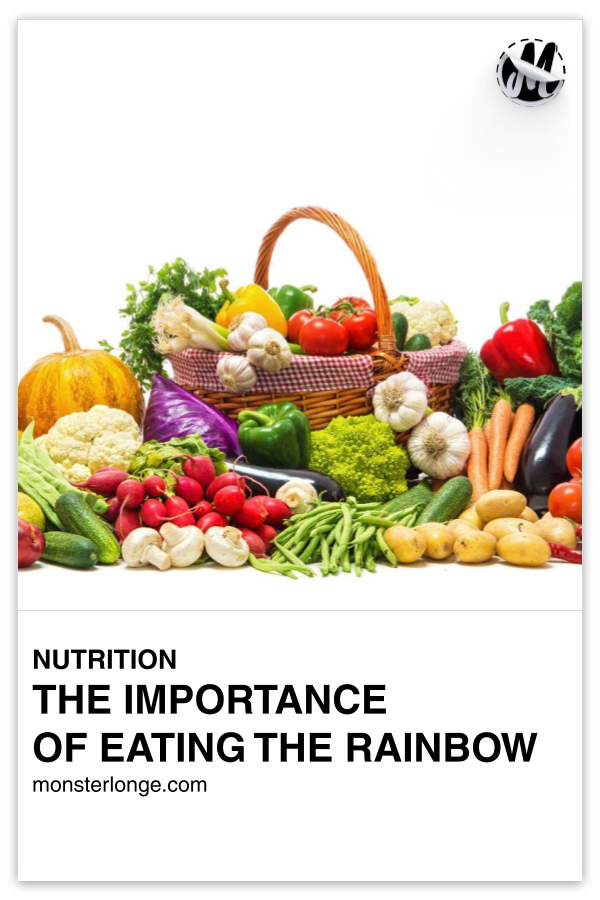
Eating The Rainbow: The Importance Of A Colorful Diet
Heard the term “eat the rainbow” before, right?
While you know that phrase is meant to instruct you to consume a variety of fruits and vegetables, what you probably don’t know is why it’s so important that you do.
So what’s the reason?
Well, not only do different fruits and vegetables contain different vitamins and minerals but they also contain different pigments, or phytonutrients. In plants, these naturally-produced compounds support the immune system to offer protection from germs, bugs, and other environmental threats and are what give fruits and vegetables their red, orange, yellow, green, blue, purple, white, or brown color. Each color has its own respective phytochemicals and when consumed by humans, research suggests that they provide a set of nutrients that have anti-inflammatory and antioxidant effects that help guard against a number of diseases and conditions.
RED
Click to expand
Fruits and vegetables that are red are rich in lycopene, which may lower the risk of diabetes, heart and lung disease, and breast and prostate cancer. The phytochemical may also reduce sun-related skin damage.
• Apples1Obviously red apples, DUH!!!
• Grapes2Obviously red grapes, DUH!!!
• Cranberries
• Cherries
• Tomatoes
• Onions3Obviously red onions, DUH!!!
• Peppers4Obviously red peppers, DUH!!!
• Beets
• Radishes5Obviously the most common color of radishes, DUH!!!
YELLOW AND ORANGE
Click to expand
Fruits and vegetables that are yellow and orange provide carotenoids that may support eye health, strengthen the immune system, and reduce the risk of heart disease.
• Apricots
• Peaches
• Oranges
• Tangerines
• Lemons
• Bananas
• Mangoes
• Papayas
• Cantaloupe
• Carrots
• Sweet Potatoes
• Peppers6Obviously yellow peppers, DUH!!!
• Pumpkin
• Winter Squash7e.g. butternut, acorn, kabocha, etc.
• Corn
GREEN
Click to expand
Fruits and vegetables that are green contain indoles and isothiocyanates, which are compounds that may prevent cancer by inhibiting the formation of tumors.
• Apples8Obviously green apples, DUH!!!
• Grapes9Obviously green grapes, DUH!!!
• Kiwis
• Avocados
• Broccoli
• Kale
• Spinach
• Asparagus
• Cabbage10Obviously green cabbage, DUH!!!
• Brussels Sprouts
• Alfalfa Sprouts
• Collard Greens
• Herbs11Obviously green herbs, DUH!!!
e.g. sage, thyme, basil, mint, rosemary, etc.
BLUE AND PURPLE
Click to expand
Anthocyanins are predominant in blue and purple fruits and vegetables. This phytonutrient is believed to improve cognitive function and reduce the risk of diabetes and certain cancers. It may also help lower blood pressure, prevent stroke, and protect against heart disease.
• Blueberries
• Blackberries
• Elderberries
• Plums
• Figs
• Grapes12Obviously concord grapes, DUH!!!
• Raisins
• Prunes
• Eggplant
• Cabbage13Obviously purple cabbage, DUH!!!
• Cauliflower14Obviously purple cauliflower, DUH!!!
• Onions15Obviously purple onions, DUH!!!
• Potatoes16Obviously purple potatoes, DUH!!!
• Lavender
BROWN AND WHITE
Click to expand
Common in brown and white fruits and vegetables are allicin and anthoxanthins, which are compounds that may have cancer-fighting properties that reduce the risk of certain cancers.
• Cauliflower17Obviously the most common color of cauliflower, DUH!!!
• Garlic
• Onions18Obviously white onions, DUH!!!
• Leeks
• Mushrooms
• Parsnips
• Potatoes19Obviously white potatoes, DUH!!!
• Jicama
• Radishes20Obviously Daikon radishes, DUH!!!
Fruits and vegetables are more than a source of vitamins and minerals. Determined by their color, they also abound in other nutrients that are linked to various health benefits. As such, it’s easy to see why consuming a balance of all colors is important.
With that said, you should eat your fruits and veggies year-round to take advantage of the nutrients and health benefits associated with each color instead of waiting until June for Pride-themed food and snacks to eat the rainbow!21Get it?
June is Pride Month and most things associated with the display of LGBT+ pride are based on the Pride flag, which is rainbow colored.
GET IT?!?!
*sigh*
- How To Eat Healthy During Thanksgiving - November 20, 2024
- Weight Loss Tip: no.2620 - November 20, 2024
- Is Going To The Gym Once A Week Enough? - November 19, 2024
